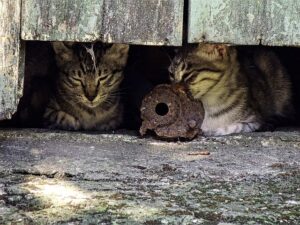Helping Community Cats
Cats can live long, healthy and fulfilled lives outside of the typical home environment. Not all cats wish to live in our homes, or even have any contact with humans. These cats deserve and need our protection and support in order to thrive.
If you have an outdoor cat or colony of cats living near you, you can help them in a variety of ways.

- Determine if the cat(s) are feral – that is to say, they do not seek out human company, and actively avoid contact. If they are strays, who have become lost or been abandoned, they can usually be taken into a rescue centre and rehomed. Contact your nearest cat welfare society for advice and further information.
2. If the cat(s) are feral, you can assist them first and foremost by ensuring they are neutered/spayed. This will improve their health and wellbeing, and prevent the birth of multiple litters of kittens, who will be born into a hostile environment, may not survive into adulthood, and will doubtless suffer from ill health. Contact us for advice if you would like to learn more about our Trap/Neuter/Return programme.
Cats who have been through the TNR programme will usually have the tip of an ear clipped (see photo below). This enables everyone to see they have been through the programme, and prevents them from being needlessly trapped a second time.


3.Once the cat(s) are neutered and/or spayed, you can provide them with support by setting up regular feeding spots, and ensuring they are receiving adequate nutrition by providing a steady supply of cat food (wet or dry), along with a source of fresh water.
Choose a spot to feed the cats which is sheltered, and away from prevailing winds. Always ensure the area you choose has multiple points of entry and exit. This will ensure all the cats in the community will be able to access the food.
It is a good idea to feed community cats on a schedule; the cats will learn the schedule, and you can check them all at feeding time, to ensure all are present, looking healthy, and that no new, intact, cats have joined the colony.


4. Cats living outside will always find somewhere to shelter from inclement weather, but you can help them by providing somewhere for them to safely rest, which will be warm and dry. You can use wooden boxes lined with straw or blankets (which will need to be changed/washed from time to time), or purpose-built cat shelters which can be purchased inexpensively from various retailers.


